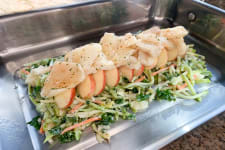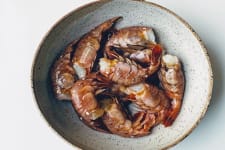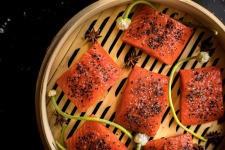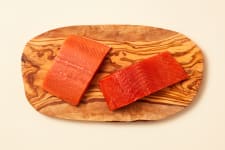Now and again, a full-circle experience occurs that feels as though it was ordained by history itself. This is exactly how it felt earlier this year when Wild Alaskan Company acquired Home Port Seafoods, a family-owned custom seafood processing facility located in Bellingham, Washington (the same town where a young college student, my husband Arron, WAC’s founder + CEO, once held a warehouse job shoveling ice).
Several years ago, before Arron started the company, we embarked on a research expedition, our objective being to understand the nuances of the Alaskan seafood industry more deeply. Even though Arron grew up each summer fishing for sockeye salmon in the silver waters of Bristol Bay, Alaska — and as such knew a fair amount about what it takes to harvest that particular species — we knew there was so much more to discover across the vastness of Alaskan seafood as a whole. From cleaning and filleting seafood en masse to packaging and distributing the seafood throughout the nation, it was evident that if we wanted to offer a line of products in service of said seafood, we’d have to profoundly grasp the vertically integrated supply chain in which it is made widely possible.
In planning for this journey, one of Arron’s first phone calls was to Home Port Seafoods, a family-owned business and sort of unofficial gateway between Alaskan seafood and the rest of the country. As part of its journey to our members, seafood is often sent from Alaska to Home Port, where it is processed into individually sealed, ready-to-cook portions — which means Home Port essentially does the work that you don’t have to do at home.
Christie, the daughter of Home Port’s founders, who has overseen the company’s day-to-day operations since the mid-2000s, not only graciously took Arron’s cold call but agreed to let us visit. With our lab coats and hairnets on and Christie at the helm, we toured the facility, a multi-warehouse complex where volumes of diverse Alaskan seafood are processed each day for distribution. We encountered state-of-the-art machinery and assembly lines occupied by workers whose eyes and gloved hands appeared to move in a synchronized choreography.
It was one thing to see all of those impressive machines designed and made for the sole purpose of processing seafood, but what struck us the most was the evident savvy of those who worked the line, their ethos of grit, and their collective meticulousness. And most of all, the feeling that Christie viewed and treated each and every one of those individuals as a member of her own family.
We left that trip inspired by Christie’s operation, motivated to plow forward with our own, and mostly grateful to her for being the first to take a chance on us by agreeing to start processing the first of our fish. In our early days, there was no question that we were one of her smallest customers, but that certainly didn’t stop her from taking us on and treating us with the same unconditional love and respect with which we witnessed her treat everyone else.
Five years later, when Christie’s parents sold Home Port to us, and we officially promoted Christie to its CEO, it felt more like a marriage than an acquisition, the distinctive feeling that we were indeed coming home. Our beginning became our continuance, our first step now unequivocally propelling us into the future. With Home Port Seafoods as a part of our world, our company would mature, and our understanding of the seafood world would continue to evolve.
And for me personally, something else would also occur. Shortly after we acquired Home Port, we held an intercompany welcome barbeque. We had a chance to bond with the Home Port team, an incredibly diverse workforce with roots stretching across the Americas and Asia. Personally, I was struck by the fact that much of the plant’s labor force was Hispanic, from countries like El Salvador, Mexico, Honduras, and Guatemala. Some of the team members had worked on the processing line cleaning and cutting fish at Home Port for well over two decades. The quality of the products that WAC’s members regularly receive is attributable to the elemental variable of these individuals’ hard-working hands.
As I looked out onto the crowd that day, I felt a tremendous surge of pride in the fact that I could address this new cohort of teammates — in Spanish! — officially welcoming them to the WAC fish fam in a new era of connectivity between the Hispanic workforce and their contribution to our mission to accelerate humanity’s transition to sustainable food systems. Having been born in Colombia myself, with Spanish as my own native tongue, the moment was laden with a mix of so many beautiful sentiments. I was proud to be part of a team that was growing more diverse by the day, happy that I could have a meaningful exchange with our new teammates from a place of cultural relatability, and, of course, excited for the future of WAC and its ever-cherished members.
As we celebrate National Hispanic Heritage Month this year, I look to my new friends at Home Port, whose daily efforts make our seafood a viable product for us all to enjoy regularly. From the bottom of my heart, I honor and thank each and every one of them.
Live wild,
Monica
Pictured above: WAC’s teammates at Home Port Seafoods, the maestros behind the perfectly portioned cuts of fish that you receive in every box.






